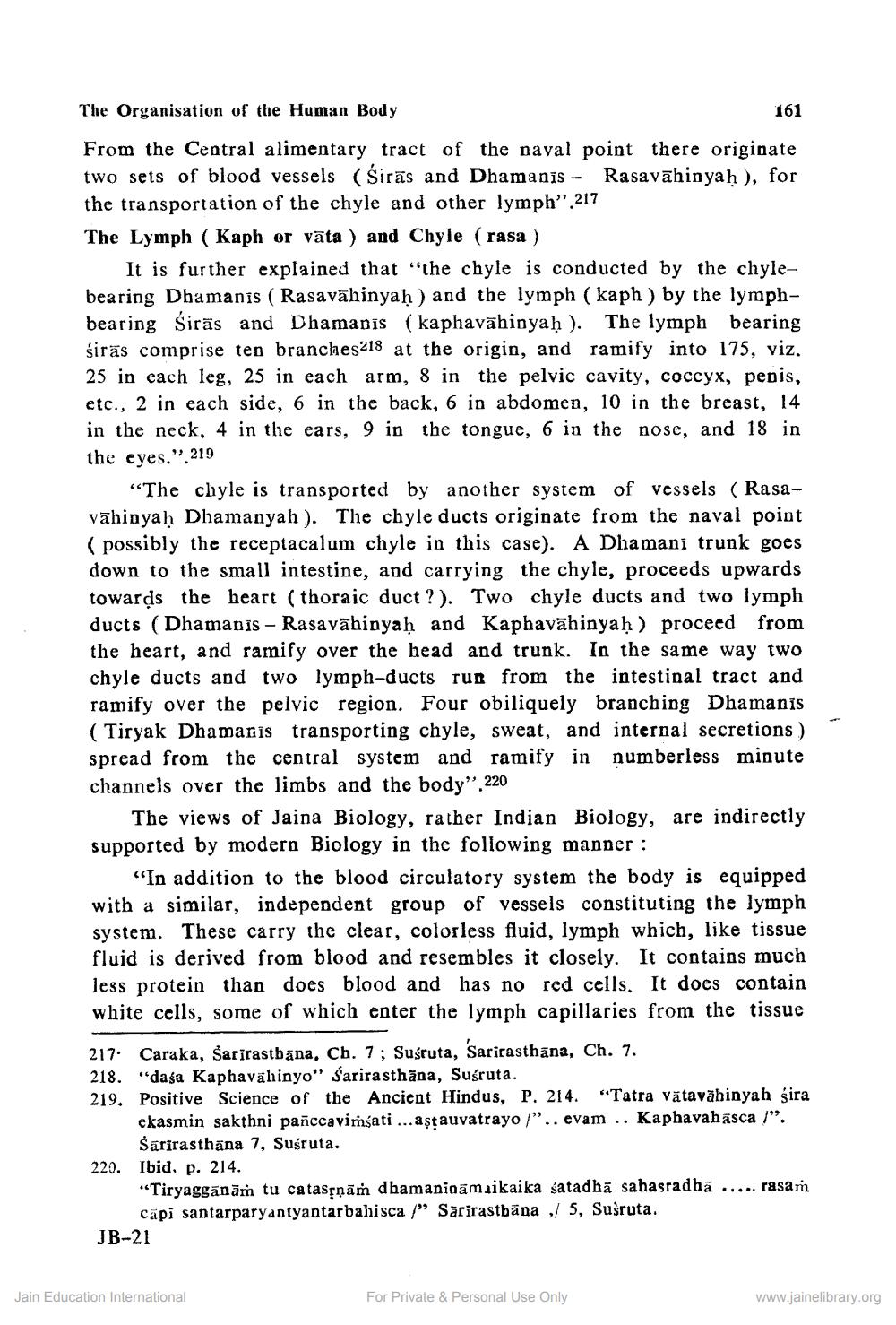________________
The Organisation of the Human Body
161 From the Central alimentary tract of the naval point there originate two sets of blood vessels (Širās and Dhamanis - Rasavāhinyaḥ), for the transportation of the chyle and other lymph”.217 The Lymph ( Kaph or vāta ) and Chyle (rasa )
It is further explained that "the chyle is conducted by the chylebearing Dhamanis ( Rasavāhinyaḥ ) and the lymph ( kaph ) by the lymphbearing Sirās and Dhamanis (kaphavāhinyah ). The lymph bearing širäs comprise ten branches218 at the origin, and ramify into 175, viz. 25 in each leg, 25 in each arm, 8 in the pelvic cavity, coccyx, penis, etc., 2 in each side, 6 in the back, 6 in abdomen, 10 in the breast, 14 in the neck, 4 in the ears, 9 in the tongue, 6 in the nose, and 18 in the eyes.".219
“The chyle is transported by another system of vessels (Rasavāhinyaḥ Dhamanyah). The chyle ducts originate from the naval point ( possibly the receptacalum chyle in this case). A Dhamani trunk goes down to the small intestine, and carrying the chyle, proceeds upwards towards the heart (thoraic duct?). Two chyle ducts and two lymph ducts (Dhamanis - Rasavāhinyaḥ and Kaphavāhinyaḥ) proceed from the heart, and ramify over the head and trunk. In the same way two chyle ducts and two lymph-ducts run from the intestinal tract and ramify over the pelvic region. Four obiliquely branching Dhamanis ( Tiryak Dhamanis transporting chyle, sweat, and internal secretions) spread from the central system and ramify in numberless minute channels over the limbs and the body'. 220
The views of Jaina Biology, rather Indian Biology, are indirectly supported by modern Biology in the following manner :
"In addition to the blood circulatory system the body is equipped with a similar, independent group of vessels constituting the lymph system. These carry the clear, colorless fluid, lymph which, like tissue fluid is derived from blood and resembles it closely. It contains much less protein than does blood and has no red cells. It does contain white cells, some of which enter the lymph capillaries from the tissue
217. Caraka, Šarirastbana, Ch.7; Susruta, Sarirasthāna, Ch. 7. 218. "dasa Kaphavāhinyo" Śarirasthāna, Suśruta. 219, Positive Science of the Ancient Hindus, P. 214. "Tatra Vātavāhinyah sira
ekasmin sakthni pañccavimšati ... aştauvatrayo!"..evam .. Kaphavahasca”.
Sarirasthāna 7, Susruta. 220. Ibid. p. 214.
"Tiryagganām tu catasrņām dhamanioamaikaika satadha sahasradha ..... rasam
Capi santarparyantyantarbahisca /" Sarirastbāna ,/ 5, Susruta. JB-21
Jain Education International
For Private & Personal Use Only
www.jainelibrary.org




